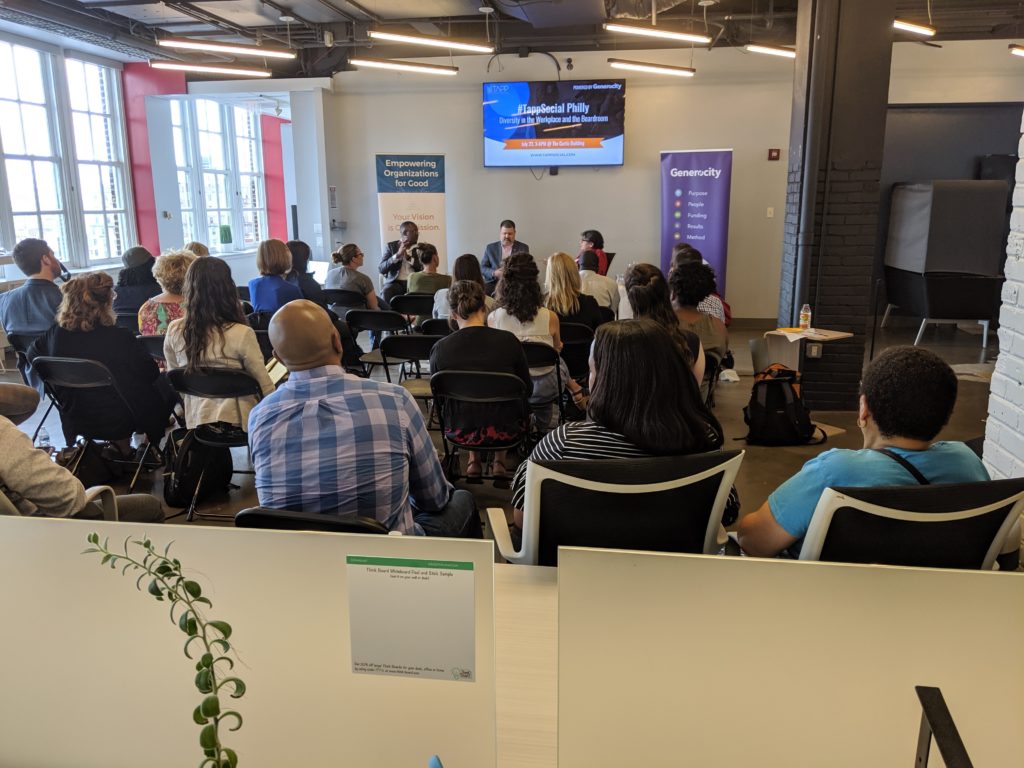Talking about workplace diversity and inclusion at Philly’s first #TappSocial
 August 2, 2019
Category: Featured, Medium, Purpose
August 2, 2019
Category: Featured, Medium, Purpose
Disclosures
This is a guest post by Jenn Wells, creative director of Tapp Network.Does diversity matter? What’s the difference between diversity and inclusion? Equity and equality?
Those questions are just a few that were addressed at Philly’s first #TappSocial about Diversity in the Workplace and the Boardroom. The event, which took place at the coworking space 1776 on July 23, featured speakers from very different backgrounds:
- Sulaiman Rahman, CEO and founder of DiverseForce
- Pete Freudenberger, outreach manager of the Steven A. Cohen Military Family clinic
- Sabrina Vourvoulias, editor of Generocity

TappSocial’s Diversity and inclusion in the workplace and boardroom July 23. (Photo courtesy of Tapp Network)
Does Diversity Matter?
Beyond just a desire to be a well-rounded society that embraces and supports all of our components rather than just the majority, diversity has a positive impact on corporate financial well-being. Companies in the top 25th percentile for gender diversity on their executive teams are 21% more likely to experience above-average profits. And that number goes all the way up to 33% when those teams include ethnic diversity.
“Diversity is counting heads. Inclusion is making sure the heads count.” As Rahman pointed out during the discussion, it’s not enough to go after numbers that represent diversity. A company culture needs to be inclusive and welcome all the different ideas and experiences that come from having diverse staff. Otherwise staff members will feel stifled and not contribute, which defeats the purpose.
The quote also raised an interesting point about visible versus invisible diversity. The group discussed the different ways a group can be diverse, beyond just visible traits like race or gender — such as ability, sexuality, or military service. They suggested focusing on the experiences and skills people can bring to the table when selecting board members or employees, rather than filling a quota.
“Equality is giving everyone the same size shoe. Equity is giving everyone the shoe that fits best.” Another apt quote from Rahman, this addressed the difference between equity and equality, while opening the door for a conversation about how to provide equity in the workplace.
Freudenberger answered a few audience questions with suggestions about how to accommodate those with disabilities while Rahman discussed checking personal bias during the hiring and promotion processes.
Unconscious bias is always a hot topic because it’s harder to address. While there’s not much you can do on your own (other than pausing to question your decisions), the panel suggested connecting with people with different experiences who can “bias check” you. They also warned of the inherent dangers of rejecting candidates for not being a “culture fit” because too often choosing only people who fit the company culture means avoiding change, new ideas, and even innovation.
Practical tips to incorporate diversity in your organization
There were so many nuggets of wisdom, but we broke it down into a few actionable points:
- Make it part of your mission to represent your constituents by hiring people from that group or that can speak to their experiences
- Create a composition matrix to show the diversity make-up your organization is aiming for
- List out the experiences you want from the individuals involved with or contributing to your board
- Remember to look at your vendors, as well as employees
- Try resource groups (like DiverseForce) that help companies and organizations place diverse staff members
- Make sure everyone gets a chance to speak and…
- Speak to the audience you’re trying to attract
We’ll end with the story shared by Vourvoulias about why that last point is particularly important. The story goes that Chevrolet decided to expand their sales to the Latin American market. The car they decided to sell was the then-popular Chevy Nova. It didn’t sell.
Why? Because the Latino market wanted nothing to do with a car that “no va” or “doesn’t go.”
Trending News









